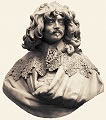|
|
 |
Male
Footwear
|
 |
First
half of 17th century
Boots became
fashionable at the English court during Charles I's reign. Charles
had probably rickets when he was a child and it was feared that
he would never walk without the aid of calipers. But then a shoemaker
designed boots for him, which had hidden brass supports in the heel
and at the ankle. Although he could later walk without these supports,
by the time he became king, boots were indispensable in the wardrobe
of the gentleman at court. They were worn by all classes, over pantaloons
or breeches. Made from cordovan leather, they crumpled softly down
the leg. A large piece of butterfly shaped leather (spur leathers)
was stitched across the instep to hold the gold or silver rowel
spurs.
Less extravagant
were boots made from buff leather (cowhide), which was heavier and
more durable. The lace-edged boothose, which were worn inside the
boots by the gentlemen, were usually made of linen, and protected
the delicate silk stockings from being soiled by the leather. Already
in 1627 gentlemen were wearing light-coloured boots with red heels
and the edges of the soles stained red. The red heel became popular
for aristocratic and court wear in the 1630s and continued in fashion
well into the 18th century. By 1630, a protective additional sole galosh made from thick leather or wood, was used to keep
the fine boots and shoes from the dirt of the streets. Shoes, by
that time less fashionable for the gentleman, were ankle-high, with
the sides cut out, and closed with satin ribbons. The heels came
well under the instep and were about 2 inches high, covered in leather
with matching or contrasting colour. The side seams had become shortened,
and the vamp and quarters were cut away to leave an oval opening,
small on the more practical footwear, but very big on the highly
fashionable one. The shoes were mostly light coloured (especially
white), while the favourite colours for boots, in addition to the
light coloured dress boots, were chestnut, dark brown and black.
The footwear
was mostly made of leather, also waxed leather, while indoor slippers
(mules) were made of silk. The toes became already square in 1610-20,
a shape which was to dominate the whole period. While the aristocracy
preferred the light, high heeled shoes and boots, the working class
wore more practical and cheaper shoes, which were low heeled. They
were usually dark brown, with leather latchet ties, deep square
toes and closed sides. The lace ties of the upper class's shoes
were either the above mentioned ribbons, often developing into elaborate
roses of ribbon lace, being further decorated with pearls or spangles.
Often they became grotesquely big. In addition to those roses, the
shoes themselves were frequently pinked or slashed, or embroidered
with floral patterns. By the 1630s the roses were no longer decorated
with spangles, and were now of woven material rather than lace,
usually made of silk.

Second
half of 17th century
Shoes and stockings
became very important, because with the advent of tailored coat
and rather tight breeches, they became the lower body's eyecatcher,
and were thus once again, similar to the high middle-ages and the
Spanish fashion of the 16th century, a focus of fashion and of etiquette,
the male leg regaining importance, and men, especially Louis XIV
himself, were proud of their long, shapely legs, in case they had
them...
The elegant
stockings were made of silk, and the most elegant and expensive
ones were embroidered at outer ankles and at the heel. The shoes
were extremely elegant as well: the square toe became longer and
very square, the heels became higher.
Since Louis
XIV was rather short, he wore heels and soles which were raised
with cork, and were then covered with red leather. These red heels
and red edged shoes remained a privilege for the French nobility
until the French Revolution. The decoration of the shoe went through
a similar development as did the clothes: in the 1660s shoes were
still decorated extensively with ribbons, rosettes, etc., until
buckles became fashionable in the 1670s, and in the 1680s shoes
had completely lost all decorations except a small buckle at the
side. Boots went completely out of fashion and were only worn in
the military and for riding, never indoors as was done in the first
half of the 17th century.
The year 1660,
with Louis XIV making at his maturity Paris the capital of the western
world, marks the beginning of French leadership in fashion, which
preferred shoes for men rather than boots. The boots still worn
in the 1660s were an exaggerated version of the 1630s soft wide
boots. Only as late as in the 1690s a heavy boot entered fashion
again, which by then has become rigid, and was worn mainly as a
riding or military boot, not any longer as a dress boot. The reasons
for this development might be as such: first of all France rose
in its power, while Charles II in England had a French background
(he was exiled there), and furthermore boots were a reminder of
Civil War in England, and therefore disappeared as fashion, but
continued for riding. Charles II had lived much of his life in France
and he was 30 when he was crowned King of England. Therefore his
taste was French.
From 1660 for
about ten years after, cannons were fashionable, which were decorative
frills below the knee on the breeches underneath the petticoat breeches.
Therefore shoes were now worn, still being decorated with large
bows made from ribbon to match or contrast with the colour of the
shoes and garters were tied at the knee with ribbon bows at the
side of the leg. For men, black and browns were the usual colours
in the 1660s. The red sole and heel, a French court fashion, had
been long adopted in England as well. White leather was still usually
worn at court, while some buff or suede leathers were also in use.
The toes were long and square, sometime forked, and overhanging
the sole.
By 1676 some
toes were beginning to be blocked, the end presenting a curved,
classical pediment shape. They were quite narrow in the 1680s, but
began to widen again in the 1690s. Around 1710 wide, square domed
toes with medium high heel and very high tongue were fashionable.
The heels of
men's and women's shoes were similar for a long time, and they were
made of wood covered in leather to match or contrast with the shoes.
There were more stacked heels for men and generally most riding
boots used the stocked heel. Until 1700 heels were quite slender,
but the shoes with the wide domed toe of the 1710s had a massive
heel to balance, flaring out from the seat, hollowed up in the centre
for lightness.
The latchet
tie shoes continued from the first half, but they became closed
at the sides now. The ribbon ties changed as well. There were, as
mentioned above, multiple ribbons like floppy bows and few butterfly
bows in the 1660s-1670s, but they changed to a much stiffer, formalised
wide bows. The first shoe buckles already appeared in the 1660s
and were small, oblong ovals, set with stones or glass. But it took
a while until buckles became the accepted fashion. Thus the early
solution of tying a shoe was a buckle with a stud to lock through
a hole in the latchet. The other straps tended to be narrow and
the buckle, with a single spike, often appeared at the side rather
than the front. From the very beginning on, buckles were treated
as jewellery, transferable from one shoe to the other. Sometimes
both buckles and ribbons were worn. From 1710 onwards a larger buckle
was more appropriate for the heavier shoes, and the straps were
cut wider to carry it, and of equal length, to take a different
chape. Throughout the period the buckle or lace was set high on
the instep, with the tongue extending above.
During the
1660s-1680s the tongue was soft and allowed to fold over, but from
ca. 1690 on it was stiffened with a lining. The cut of the tongue
was of the above mentioned fancy shapes, so that the contrasting
lining took such forms as a cupid's bow. Red lining was most popular
on men's black shoes and they had red heels with the edges of the
shoes reddened. Those shoes were for dress wear at court in the
1680s. For indoor wear slippers retained the mule form and had low
heels. There was a variety of colours and materials, usually brocade
and silk, often embroidered. They were worn by men and women.

Female
Costumes
Ladies' Baroque Clothing
Indoor
Garments | Footwear | Accessories | Hairstyles | Head-dresses | Development
of the Fontange
Hairstyles
by Vermeer | Dress
Colours by Vermeer | Head-dresses
by Vermeer
Costume Focus Headwear & Neckwear | Costume
Focus Working Women
Costume
Focus Children's Clothing
Ladies'
Costume Quotes
Male
Costumes
Gentlemen's Baroque
Clothing
Indoor
Garments | Footwear | Accessories | Hairstyles | Head-dresses
Costume
Colours by Vermeer | Hair-
and Head-dresses by Vermeer
Gentlemen's
Costume Quotes
~ ~ ~ ~ ~ ~ ~ ~ ~ ~ ~ ~ ~
Embroidery Gallery | Gallery of Needlework
Engravings
Lace Gallery &
Identification | Glossary
Contents © N. Kipar 1997 |









